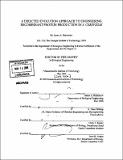A directed evolution approach to engineering recombinant protein production in S. cerevisiae
Author(s)
Rakestraw, James A
DownloadFull printable version (37.06Mb)
Other Contributors
Massachusetts Institute of Technology. Biological Engineering Division.
Advisor
K. Dane Wittrup.
Terms of use
Metadata
Show full item recordAbstract
The continued success of protein therapeutics has put a strain on industry's ability to meet the large demand. Creating a more productive expression host for the manufacture of these proteins is a potential solution. Although heterologous proteins are frequently made in organisms as disparate as E. coli and bovines, the single-celled organism S. cerevisiae has emerged as a well-qualified candidate due to its approachable genetic and fermentation attributes as well as its ability to stably fold disulfide bonded and multi domain proteins. Because S. cerevisiae screens for enhanced protein secretion have traditionally utilized low-throughput and often plate-based methods, a high-throughput, liquid phase assay could offer a real advantage in secretory selection. In this thesis, yeast surface display is investigated as a potential proxy for heterologous protein secretion. Although ultimately unsuitable as a screening proxy, the surface display experiments did show a novel method of improving protein secretion by co-expressing a more stably folded protein with the protein of interest. In these studies the secretion of an scFv-Aga2p fusion was stimulated 1 0-fold by the concomitant surface expression of BPTI. (cont.) BPTI surface expression also stimulated the secretion of secreted scFv three-fold suggesting a niche for protein coexpression as well as secretion by way of Aga2p fusions. A new screening method was developed that involves the capture of secreted protein on the surface of the cell where it can be labeled and sorted by FACS. This new method was verified to achieve thirty-five fold enrichment per pass for a three-fold enhanced protein secretor making it easily suitable for screening. The new screening methodology, the Cell Surface Secretion Assay (CeSSA), was also modeled and verified with time course data that enabled optimization of sort parameters and predicted sort outcomes based on user-derived selection parameters. The CeSSA was used to screen a library of mutant yeast alpha mating factor leader sequences for improved secretion of the scFv 4m5.3. The improved leaders imparted up to a twenty-fold improvement in scFv secretion per cell and up to thirty-fold improvement after expression tuning. These engineered leader sequences also conferred improved secretion on other scFv's and proteins including whole IgG. Moreover, the leader sequence mutants give indications of where the important residues in secretory leaders lie and the aberrations in protein traffic that result in reduced secretion.
Description
Thesis (Ph. D.)--Massachusetts Institute of Technology, Biological Engineering Division, 2006. Vita. Includes bibliographical references.
Date issued
2006Department
Massachusetts Institute of Technology. Department of Biological EngineeringPublisher
Massachusetts Institute of Technology
Keywords
Biological Engineering Division.